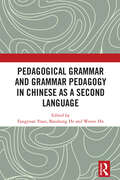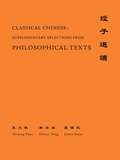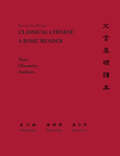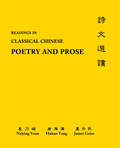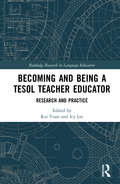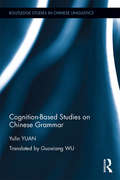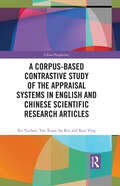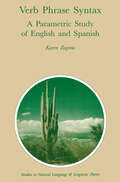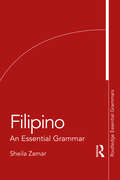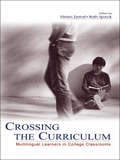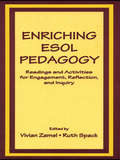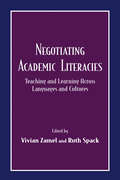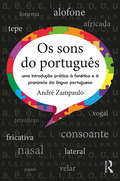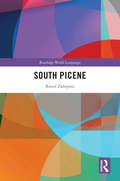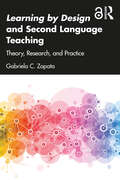- Table View
- List View
Pedagogical Grammar and Grammar Pedagogy in Chinese as a Second Language
by Fangyuan Yuan Baozhang He Wenze HuPedagogical Grammar and Grammar Pedagogy in Chinese as a Second Language is the first book in the field of Chinese as a second language that brings together one overview article and eleven research studies surrounding the key words "grammar" "pedagogy" and "Chinese as a second language." The book is a dedication to the 60th anniversary of the Chinese Language Teachers Association – U.S. The studies included draw on different theoretical frameworks, adopt a range of methodological strategies, and address the questions of how grammatical knowledge should be effectively presented and in what capacity grammar competence could be better developed in and outside classrooms, based on which pedagogical recommendations and implications are advanced. The publication of this monograph is aimed at three goals: to promote a dialogue between the field of Chinese as a second language and general field of second/foreign language teaching and learning; to bridge a link among researchers in Chinese linguistics and Chinese applied linguistics; and to establish a closer tie between research and classroom practices in L2 Chinese. This monograph is intended for Chinese instructors, teacher educators, and graduate students and ideally suited for graduate courses and teacher training programs. It also provides insights for curriculum developers, material writers, and administrators.
Classical Chinese: Selections from Historical Texts (The Princeton Language Program: Modern Chinese #52)
by Naiying Yuan James Geiss Hai-tao TangSupplementary readings to Classical Chinese: A Basic Reader—a must for every student of ChineseThis book presents selected historical texts and annotations to instruct, inform, and inspire students of Chinese. Taken from the works known as the Four Histories, these texts offer insights into the political, social, economic, and cultural aspects of China over a long period of time. The comprehensive annotations provide full pronunciation in pinyin, the grammatical function of individual words, and a full explication of the texts.One of the supplementary readings to Classical Chinese: A Basic Reader, this volume includes eight selections from the Shi Ji and two each from the Han Shu, the Hou Han Shu, and the San Guo Zhi. Each unfolds a fascinating account of the historical events and figures that represent certain salient values or distinctive cultural characteristics of what has come to be the Chinese tradition.The Shi Ji, a grand history by Sima Qian chronicling three thousand years of Chinese history, is divided into five sections of 130 chapters. Sima Qian is especially noted for his biographical style, and his work is considered the first and only "universal history" of China. The Han Shu, by Ban Gu, recounts the history of a single dynasty and is known for its dynastic style in depicting history. Together, these two histories represent paradigms of Chinese historiography. The Hou Han Shu, by Fan Ye, and the San Guo Zhi, by Chen Shou, continue this tradition of excellence. These four works are known collectively as the Four Histories.All texts are fully annotated to include a pinyin version marking the pronunciation of each word, glosses of each word by grammatical function and its meaning in the text, as well as detailed explication of each word. The exercises at the end of each selection are intended to help students apply newly gained knowledge, better appreciate Chinese history, and stimulate interest in additional reading.
Classical Chinese: Selections from Philosophical Texts (PDF) (Supplement #4)
by Naiying Yuan Hai-Tao Tang James GeissClassical Chinese: Selections from Philosophical Texts continues the rigorous standard set forth in the main, three-volume Classical Chinese: A Basic Reader. Organized into four sections, this supplementary volume sets forth the key concepts and writings of Confucius, Mencius, Laozi, and Zhuangzi-providing key insight into their beliefs and literary styles. The beauty of these original texts and the insightful annotations that accompany them will provide students of Chinese with a glimpse into the fountainhead of China's intellectual tradition. The main text and its four supplementary volumes together represent the most comprehensive and authoritative textbook on the language, literature, philosophy, history, and religion of premodern China. Rigorously and extensively field-tested and fine-tuned for years in classroom settings by three members of the Chinese Linguistics Project at Princeton University, it sets a new standard for the field. With Classical Chinese: A Basic Reader and its supplementary volumes, Naiying Yuan, Haitao Tang, and James Geiss provide the definitive new resource for students and instructors of classical Chinese language and culture, one whose impact will be lasting.
Classical Chinese: A Basic Reader (PDF)
by Naiying Yuan Haitao Tang James GeissClassical Chinese is the most comprehensive and authoritative textbook on the language, literature, philosophy, history, and religion of premodern China. Rigorously and extensively field-tested and fine-tuned for years in classroom settings, it sets a new standard for the field. Originally published in three volumes, Classical Chinese appears here in one convenient and easy-to-use volume.Classical Chinese contains forty selections from texts written between the fifth century BC and the first century AD, during which the classical Chinese language was fully developed and standardized. These passages, which express key themes in Chinese humor, wit, wisdom, moral conviction, and political ideals, are arranged in the order of complexity of the grammatical patterns they exemplify. Uniquely, each text is translated into both modern Chinese and English. A detailed glossary defines unfamiliar terms and names found in the first part of the textbook, and the last section features in-depth grammatical analyses, in which every sentence in the main selections is fully diagrammed to show the grammatical relations between their various parts. Corresponding exercises review and reinforce the materials. Four supplementary volumes—an introduction to grammar, readings in poetry and prose, selected historical texts, and selected philosophical texts—are separately available for use in conjunction with this basic reader.Classical Chinese provides a definitive resource for students and instructors of classical Chinese language and culture.
Classical Chinese: Readings in Poetry and Prose (PDF) (The Princeton Language Program: Modern Chinese #14)
by Naiying Yuan Hai-Tao Tang James GeissThis supplemental volume continues the rigorous standard set forth in the main, three-volume Classical Chinese: A Basic Reader while reinforcing its linguistic lessons from carefully chosen representative works. Comprised of three parts--"Poetry," "Lyrics," and "Prose"--it presents texts, chronologically, that represent the artistic embodiment of China's Confucian and Taoist thought. Two introductions separately describe the structural and formal features of regulated verse and parallel prose; each genre is unique to Chinese literature yet both share common characteristics tempered by the Chinese language. The main text and its four supplementary volumes together represent the most comprehensive and authoritative textbook on the language, literature, philosophy, history, and religion of premodern China. Field-tested and fine-tuned for years in classroom settings by three members of the Chinese Linguistics Project at Princeton University, it is the definitive new resource for students and instructors of classical Chinese language or culture.
Classical Chinese: Selections from Philosophical Texts (PDF) (The Princeton Language Program: Modern Chinese Ser. #16)
by Naiying Yuan Hai-Tao Tang James GeissClassical Chinese: Selections from Philosophical Texts continues the rigorous standard set forth in the main, three-volume Classical Chinese: A Basic Reader. Organized into four sections, this supplementary volume sets forth the key concepts and writings of Confucius, Mencius, Laozi, and Zhuangzi-providing key insight into their beliefs and literary styles. The beauty of these original texts and the insightful annotations that accompany them will provide students of Chinese with a glimpse into the fountainhead of China's intellectual tradition. The main text and its four supplementary volumes together represent the most comprehensive and authoritative textbook on the language, literature, philosophy, history, and religion of premodern China. Rigorously and extensively field-tested and fine-tuned for years in classroom settings by three members of the Chinese Linguistics Project at Princeton University, it sets a new standard for the field. With Classical Chinese: A Basic Reader and its supplementary volumes, Naiying Yuan, Haitao Tang, and James Geiss provide the definitive new resource for students and instructors of classical Chinese language and culture, one whose impact will be lasting.
Becoming and Being a TESOL Teacher Educator: Research and Practice (Routledge Research in Language Education)
by Rui Yuan Icy LeeThis book offers insights into the lived experiences (e.g., teaching, research, and practicum supervision) of TESOL teacher educators in diverse institutional and socio-cultural contexts. Informed by a situated, ecological perspective, it draws on a variety of research approaches (e.g., qualitative, action research, and self-study), and sheds light on how language teacher educators engage in daily practice and social interactions. This edited collection examines how TESOL educators cope with potential contextual obstacles (e.g., the theory-practice divide), and how they seek their continuing professional development in complex, shifting higher education settings. The book offers critical and thoughtful reflections of current practice and policies in language education and higher education, and provides practical implications on the preparation and development of frontline language teachers.
Cognition-Based Studies on Chinese Grammar (Routledge Studies in Chinese Linguistics)
by Yulin YuanIntroducing the English translations of 8 selected research articles originally written in Chinese by Professor Yuan Yulin, Cognition-based Studies on Chinese Grammar is an essential reading for researchers in Chinese syntax. Yuan Yulin is one of the very first Chinese scholars who introduced cognitive sciences into the study of Chinese language some twenty years ago, and his work is well-known and highly regarded in China for its originality and theoretical contribution. The collection covers the core of his engagement with Chinese language studies, ranging from lexical exploration to grammatical discussion. Cognition-based Studies on Chinese Grammar is designed for students or researchers who specialize in the Chinese language, contemporary Chinese grammar and cognitive linguistics. It can also serve as a reference book for instructors or teachers engaged in Chinese language pedagogy or in teaching Chinese as a second or foreign language.
Cognition-Based Studies on Chinese Grammar (Routledge Studies in Chinese Linguistics)
by Yulin YuanIntroducing the English translations of 8 selected research articles originally written in Chinese by Professor Yuan Yulin, Cognition-based Studies on Chinese Grammar is an essential reading for researchers in Chinese syntax. Yuan Yulin is one of the very first Chinese scholars who introduced cognitive sciences into the study of Chinese language some twenty years ago, and his work is well-known and highly regarded in China for its originality and theoretical contribution. The collection covers the core of his engagement with Chinese language studies, ranging from lexical exploration to grammatical discussion. Cognition-based Studies on Chinese Grammar is designed for students or researchers who specialize in the Chinese language, contemporary Chinese grammar and cognitive linguistics. It can also serve as a reference book for instructors or teachers engaged in Chinese language pedagogy or in teaching Chinese as a second or foreign language.
A Corpus-based Contrastive Study of the Appraisal Systems in English and Chinese Scientific Research Articles (China Perspectives)
by Xu Yuchen Yan Xuan Su Rui Kou YingAppraisal is the way language users express their attitude towards things, people, behaviour or ideas. In the last few decades, significant achievements have been made in Appraisal Theory research, yet little attention has been paid to appraisal in scientific texts, especially in relation to the contrast to how it is applied in English and Chinese. This title examines the similarities and differences of Appraisal systems in English and Chinese scientific research articles. Using a self-constructed corpus of scientific research articles, the authors make cross-linguistic comparisons in terms of the quantity and distribution patterns of categories of appraisals. They creatively categorise articles into theoretical scientific research articles and applied studies and discover that for both languages, each genre can have its own favorite mode of distribution for the realization of appraisal systems. In addition, this research helps appraisal theory systems to become more explicit, specific, and more applicable for the analysis of scientific research articles. Students and scholars of applied linguistics, comparative linguistics and corpus linguistics will find this an essential reference.
A Corpus-based Contrastive Study of the Appraisal Systems in English and Chinese Scientific Research Articles (China Perspectives)
by Xu Yuchen Yan Xuan Su Rui Kou YingAppraisal is the way language users express their attitude towards things, people, behaviour or ideas. In the last few decades, significant achievements have been made in Appraisal Theory research, yet little attention has been paid to appraisal in scientific texts, especially in relation to the contrast to how it is applied in English and Chinese. This title examines the similarities and differences of Appraisal systems in English and Chinese scientific research articles. Using a self-constructed corpus of scientific research articles, the authors make cross-linguistic comparisons in terms of the quantity and distribution patterns of categories of appraisals. They creatively categorise articles into theoretical scientific research articles and applied studies and discover that for both languages, each genre can have its own favorite mode of distribution for the realization of appraisal systems. In addition, this research helps appraisal theory systems to become more explicit, specific, and more applicable for the analysis of scientific research articles. Students and scholars of applied linguistics, comparative linguistics and corpus linguistics will find this an essential reference.
Verb Phrase Syntax: A Parametric Study of English and Spanish (Studies in Natural Language and Linguistic Theory #13)
by Karen ZagonaThis study is concerned with the structure of verb phrases in English and Spanish, and with syntactic processes involving VP and Vo. A primary focus of attention is auxiliary verbs. It is argued that the structure dominating these verbs is essentially the same in English and Spanish, as is the structure dominating auxiliaries and 'main' verbs in each language. It must be concluded that the occurrence of distinct syntactic processes affecting auxiliaries and other VP constituents in the two languages does not follow from parametrization of phrase structure. It is argued that similarities between the two languages with respect to the composition of so-called "V*" constructions derive from the fact that VP is licensed under both clauses of the Principle of Full Interpretation, i. e. , predication and sub categorization. Distinct syntactic processes in English and Spanish are argued to follow from the fact that there are inflectional features related to each of these licensing conditions (including specification for [ ± PAST) and nominal person/number features) which affect government relations in distinct ways, resulting in parametrization of S-structure representa tions. xi ACKNOWLEDGMENTS I wish to express my appreCiatIOn to the Department of Romance Languages at the University of Washington for support for preparation of the final manuscript, and to the Department of Spanish, Italian and Portuguese at the University of Virginia for a leave during which much of this research was accomplished.
Filipino: An Essential Grammar (Routledge Essential Grammars)
by Maria Sheila ZamarFilipino: An Essential Grammar is a comprehensive and practical reference guide introducing the key grammatical forms and structures in Filipino language. This book offers a detailed exploration of key phonological, morphological, and syntactic features of Filipino that are essential to achieving high levels of proficiency in the language. Across fourteen chapters are concise explanations of important grammatical categories and linguistic features relevant in the description of Philippine languages, complemented by examples relevant for everyday conversations and easy-to-understand rules for navigating Filipino grammar. Taking into consideration the most salient grammatical aspects that need to be presented by teachers and mastered by learners of Filipino, this is the ideal reference grammar for researchers, teachers and learners of Filipino language. This book is designed for both independent and class-based study by learners of Filipino at all levels.
Filipino: An Essential Grammar (Routledge Essential Grammars)
by Maria Sheila ZamarFilipino: An Essential Grammar is a comprehensive and practical reference guide introducing the key grammatical forms and structures in Filipino language. This book offers a detailed exploration of key phonological, morphological, and syntactic features of Filipino that are essential to achieving high levels of proficiency in the language. Across fourteen chapters are concise explanations of important grammatical categories and linguistic features relevant in the description of Philippine languages, complemented by examples relevant for everyday conversations and easy-to-understand rules for navigating Filipino grammar. Taking into consideration the most salient grammatical aspects that need to be presented by teachers and mastered by learners of Filipino, this is the ideal reference grammar for researchers, teachers and learners of Filipino language. This book is designed for both independent and class-based study by learners of Filipino at all levels.
Crossing the Curriculum: Multilingual Learners in College Classrooms
by Vivian Zamel Ruth SpackAs college classrooms have become more linguistically diverse, the work of ESOL professionals has expanded to include research on the experiences of multilingual learners not only in ESOL courses but also in courses across the curriculum. At the same time that ESOL professionals are trying to understand the academic challenges that learners face beyond ESOL courses, faculty across the disciplines are trying to meet the challenge of teaching students of differing linguistic backgrounds. Crossing the Curriculum: Multilingual Learners in College Classrooms responds to these issues and concerns by capturing the complex and content-specific nature of students' and teachers' experiences and providing a nuanced understanding of how multilingual students' learning can be fostered and sustained. Crossing the Curriculum: Multilingual Learners in College Classrooms is unique in bringing together the perspectives of researchers, students, and teachers. These multiple lenses allow for a richly layered picture of how students and teachers actually experience college classrooms. Common themes and pedagogical principles resonate across the three distinct sections of the book:*Part One, "Investigating Students' Experiences Across the Curriculum: Through the Eyes of Classroom Researchers," consists of chapters written by ESOL and composition researchers who have investigated multilingual students' experiences in undergraduate courses across the curriculum.*Part Two, "Learning Across the Curriculum: Through Students' Eyes," consists of chapters written by two multilingual learners who chronicled their experiences as they crossed the curriculum over time.*Part Three, "Engaging Students in Learning: Through the Eyes of Faculty Across the Curriculum," consists of chapters written by faculty from several academic fields--Anthropology, Philosophy, Nursing, Literature, Sociology, and Asian American Studies--who discuss their own attempts to address the needs of multilingual learners in their classrooms.
Crossing the Curriculum: Multilingual Learners in College Classrooms
by Vivian Zamel Ruth SpackAs college classrooms have become more linguistically diverse, the work of ESOL professionals has expanded to include research on the experiences of multilingual learners not only in ESOL courses but also in courses across the curriculum. At the same time that ESOL professionals are trying to understand the academic challenges that learners face beyond ESOL courses, faculty across the disciplines are trying to meet the challenge of teaching students of differing linguistic backgrounds. Crossing the Curriculum: Multilingual Learners in College Classrooms responds to these issues and concerns by capturing the complex and content-specific nature of students' and teachers' experiences and providing a nuanced understanding of how multilingual students' learning can be fostered and sustained. Crossing the Curriculum: Multilingual Learners in College Classrooms is unique in bringing together the perspectives of researchers, students, and teachers. These multiple lenses allow for a richly layered picture of how students and teachers actually experience college classrooms. Common themes and pedagogical principles resonate across the three distinct sections of the book:*Part One, "Investigating Students' Experiences Across the Curriculum: Through the Eyes of Classroom Researchers," consists of chapters written by ESOL and composition researchers who have investigated multilingual students' experiences in undergraduate courses across the curriculum.*Part Two, "Learning Across the Curriculum: Through Students' Eyes," consists of chapters written by two multilingual learners who chronicled their experiences as they crossed the curriculum over time.*Part Three, "Engaging Students in Learning: Through the Eyes of Faculty Across the Curriculum," consists of chapters written by faculty from several academic fields--Anthropology, Philosophy, Nursing, Literature, Sociology, and Asian American Studies--who discuss their own attempts to address the needs of multilingual learners in their classrooms.
Enriching Esol Pedagogy: Readings and Activities for Engagement, Reflection, and Inquiry
by Vivian Zamel Ruth SpackEnriching ESOL Pedagogy: Readings and Activities for Engagement, Reflection, and Inquiry is a collection of thought-provoking articles and activities designed to engage practicing and prospective ESOL teachers in an ongoing process of reflecting on, critically examining, and investigating theory and practice. Its twofold purpose is to provide a theoretical perspective and to offer ways for making the teaching of English to speakers of other languages (ESOL) meaningful for both teachers and learners. Underlying the activities and the readings themselves is the assumption that teachers need to play a role in exploring, shaping, and theorizing the work they do. The readings included represent a range of genres. They are informed by a common philosophical perspective about language acquisition and treat language teaching and learning holistically. The book is organized into five integrated units that: * raise questions about conventional notions of methods; * take into account the complicated nature of real classrooms; * provide theoretical principles for teaching that promotes language acquisition; * include rich descriptions of actual classroom experiences; and * question assumptions about language and literacy. Each set of readings begin with a "Before Reading" section and is followed by "Reflecting on the Readings," "Reading for Further Reflection," and "Suggested Projects for Inquiry" sections. This volume is a valuable resource for practicing and prospective teachers in the field of TESOL who work with diverse student populations--at all levels--in both mainstream and ESL/bilingual settings.
Enriching Esol Pedagogy: Readings and Activities for Engagement, Reflection, and Inquiry
by Vivian Zamel Ruth SpackEnriching ESOL Pedagogy: Readings and Activities for Engagement, Reflection, and Inquiry is a collection of thought-provoking articles and activities designed to engage practicing and prospective ESOL teachers in an ongoing process of reflecting on, critically examining, and investigating theory and practice. Its twofold purpose is to provide a theoretical perspective and to offer ways for making the teaching of English to speakers of other languages (ESOL) meaningful for both teachers and learners. Underlying the activities and the readings themselves is the assumption that teachers need to play a role in exploring, shaping, and theorizing the work they do. The readings included represent a range of genres. They are informed by a common philosophical perspective about language acquisition and treat language teaching and learning holistically. The book is organized into five integrated units that: * raise questions about conventional notions of methods; * take into account the complicated nature of real classrooms; * provide theoretical principles for teaching that promotes language acquisition; * include rich descriptions of actual classroom experiences; and * question assumptions about language and literacy. Each set of readings begin with a "Before Reading" section and is followed by "Reflecting on the Readings," "Reading for Further Reflection," and "Suggested Projects for Inquiry" sections. This volume is a valuable resource for practicing and prospective teachers in the field of TESOL who work with diverse student populations--at all levels--in both mainstream and ESL/bilingual settings.
Negotiating Academic Literacies: Teaching and Learning Across Languages and Cultures
by Vivian Zamel Ruth SpackNegotiating Academic Literacies: Teaching and Learning Across Languages and Cultures is a cross-over volume in the literature between first and second language/literacy. This anthology of articles brings together different voices from a range of publications and fields and unites them in pursuit of an understanding of how academic ways of knowing are acquired. The editors preface the collection of readings with a conceptual framework that reconsiders the current debate about the nature of academic literacies. In this volume, the term academic literacies denotes multiple approaches to knowledge, including reading and writing critically. College classrooms have become sites where a number of languages and cultures intersect. This is the case not only for students who are in the process of acquiring English, but for all learners who find themselves in an academic situation that exposes them to a new set of expectations. This book is a contribution to the effort to discover ways of supporting learning across languages and cultures--and to transform views about what it means to teach and learn, to read and write, and to think and know. Unique to this volume is the inclusion of the perspectives of writers as well as those of teachers and researchers. Furthermore, the contributors reveal their own struggles and accomplishments as they themselves have attempted to negotiate academic literacies. The chronological ordering of articles provides a historical perspective, demonstrating ways in which issues related to teaching and learning across cultures have been addressed over time. The readings have consistency in terms of quality, depth, and passion; they raise important philosophical questions even as they consider practical classroom applications. The editors provide a series of questions that enable the reader to engage in a generative and exciting process of reflection and inquiry. This book is both a reference for teachers who work or plan to work with diverse learners, and a text for graduate-level courses, primarily in bilingual and ESL studies, composition studies, English education, and literacy studies.
Negotiating Academic Literacies: Teaching and Learning Across Languages and Cultures
by Vivian Zamel Ruth SpackNegotiating Academic Literacies: Teaching and Learning Across Languages and Cultures is a cross-over volume in the literature between first and second language/literacy. This anthology of articles brings together different voices from a range of publications and fields and unites them in pursuit of an understanding of how academic ways of knowing are acquired. The editors preface the collection of readings with a conceptual framework that reconsiders the current debate about the nature of academic literacies. In this volume, the term academic literacies denotes multiple approaches to knowledge, including reading and writing critically. College classrooms have become sites where a number of languages and cultures intersect. This is the case not only for students who are in the process of acquiring English, but for all learners who find themselves in an academic situation that exposes them to a new set of expectations. This book is a contribution to the effort to discover ways of supporting learning across languages and cultures--and to transform views about what it means to teach and learn, to read and write, and to think and know. Unique to this volume is the inclusion of the perspectives of writers as well as those of teachers and researchers. Furthermore, the contributors reveal their own struggles and accomplishments as they themselves have attempted to negotiate academic literacies. The chronological ordering of articles provides a historical perspective, demonstrating ways in which issues related to teaching and learning across cultures have been addressed over time. The readings have consistency in terms of quality, depth, and passion; they raise important philosophical questions even as they consider practical classroom applications. The editors provide a series of questions that enable the reader to engage in a generative and exciting process of reflection and inquiry. This book is both a reference for teachers who work or plan to work with diverse learners, and a text for graduate-level courses, primarily in bilingual and ESL studies, composition studies, English education, and literacy studies.
Os sons do português: uma introdução prática à fonética e à pronúncia da língua portuguesa (3D Photorealistic Rendering)
by André ZampauloOs sons do português is a practical introduction to the phonetics and pronunciation of Portuguese, with a focus on the sound patterns of Portuguese from a non-theoretical perspective. Written entirely in Portuguese, the book addresses the correspondence between sounds and spelling rules, syllabic structure and stress patterns of the language, as well as an introduction to phonetic notation, terminology, and transcription. Key features: Easy-to-follow organization, with gradual development from introductory to advanced material to build on students’ pre-existing knowledge of Portuguese pronunciation A range of activities, including descriptive and audio-visual exercises based on examples from cultural products of Portuguese-speaking communities Illustrative descriptions and audio-visual samples of the main dialects of the Lusophone world, particularly from Brazil and Portugal Online access to audio files that accompany the text This is an ideal resource for non-native and heritage speakers of Portuguese at level B2 – C2 of the Common European Framework for Languages, and Intermediate High – Advanced High on the ACTFL proficiency scales.
South Picene (Routledge World Languages)
by Raoul ZamponiSouth Picene is the pre-Roman language spoken in the Adriatic sector of central Italy. This book presents a description of what we know about the structure of this language. South Picene is (together with Umbrian, Oscan, Latin, and Faliscan) one of the few members of the Italic branch of the Indo-European family and is also one of the European languages with the oldest existing texts (550 BCE). Besides a grammatical outline of the language, the book contains the linguistic (and often stylistic) analysis of all the 21 inscriptions that compose the South Picene epigraphic corpus and a word list. South Picene will be of interest to students and scholars of Indo-European languages, Italic languages, and in general, ancient languages of the Italian peninsula.
South Picene (Routledge World Languages)
by Raoul ZamponiSouth Picene is the pre-Roman language spoken in the Adriatic sector of central Italy. This book presents a description of what we know about the structure of this language. South Picene is (together with Umbrian, Oscan, Latin, and Faliscan) one of the few members of the Italic branch of the Indo-European family and is also one of the European languages with the oldest existing texts (550 BCE). Besides a grammatical outline of the language, the book contains the linguistic (and often stylistic) analysis of all the 21 inscriptions that compose the South Picene epigraphic corpus and a word list. South Picene will be of interest to students and scholars of Indo-European languages, Italic languages, and in general, ancient languages of the Italian peninsula.
Learning by Design and Second Language Teaching: Theory, Research, and Practice
by Gabriela C. ZapataLearning by Design and Second Language Teaching establishes theoretical, research, and practice connections between the multiliteracies framework Learning by Design and L2 teaching and learning. A comprehensive introductory chapter presents the theoretical tenets of the approach and is followed by four chapters devoted to the establishment of connections between the framework and L2 instruction, information on evidence-based pedagogical practices and suggestions for their implementation, and task examples that can be adapted for use in a variety of educational contexts. Each chapter links theory and research to practical steps instructors can take to select authentic materials and create tasks in each of the framework’s knowledge processes with the objective of developing L2 students’ performance in the interpersonal (speaking), interpretive (reading and listening), and presentational (writing) modes of communication. A selection of guidance charts, figures, templates, and extra digital resources are included within the text to support learning and teaching. The book will be of interest to graduate students and in-service and future L2 teachers in all levels of instruction.
Learning by Design and Second Language Teaching: Theory, Research, and Practice
by Gabriela C. ZapataLearning by Design and Second Language Teaching establishes theoretical, research, and practice connections between the multiliteracies framework Learning by Design and L2 teaching and learning. A comprehensive introductory chapter presents the theoretical tenets of the approach and is followed by four chapters devoted to the establishment of connections between the framework and L2 instruction, information on evidence-based pedagogical practices and suggestions for their implementation, and task examples that can be adapted for use in a variety of educational contexts. Each chapter links theory and research to practical steps instructors can take to select authentic materials and create tasks in each of the framework’s knowledge processes with the objective of developing L2 students’ performance in the interpersonal (speaking), interpretive (reading and listening), and presentational (writing) modes of communication. A selection of guidance charts, figures, templates, and extra digital resources are included within the text to support learning and teaching. The book will be of interest to graduate students and in-service and future L2 teachers in all levels of instruction.
